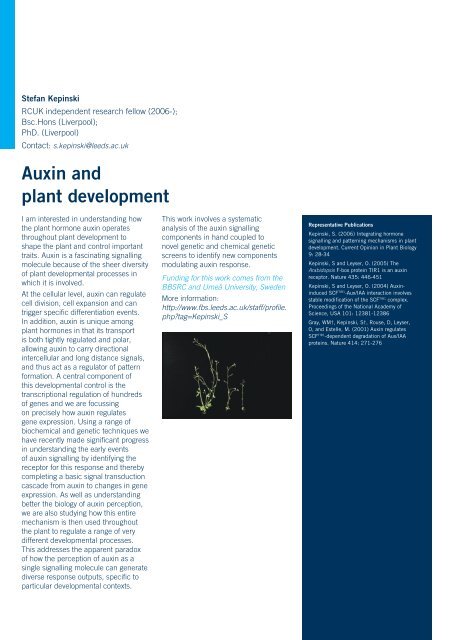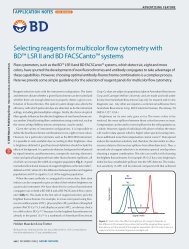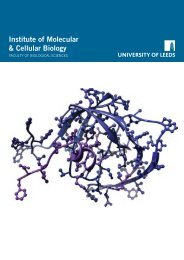3649-08 IICB.indd - Faculty of Biological Sciences - University of ...
3649-08 IICB.indd - Faculty of Biological Sciences - University of ...
3649-08 IICB.indd - Faculty of Biological Sciences - University of ...
Create successful ePaper yourself
Turn your PDF publications into a flip-book with our unique Google optimized e-Paper software.
Stefan Kepinski<br />
RCUK independent research fellow (2006-);<br />
Bsc.Hons (Liverpool);<br />
PhD. (Liverpool)<br />
Contact: s.kepinski@leeds.ac.uk<br />
Auxin and<br />
plant development<br />
I am interested in understanding how<br />
the plant hormone auxin operates<br />
throughout plant development to<br />
shape the plant and control important<br />
traits. Auxin is a fascinating signalling<br />
molecule because <strong>of</strong> the sheer diversity<br />
<strong>of</strong> plant developmental processes in<br />
which it is involved.<br />
At the cellular level, auxin can regulate<br />
cell division, cell expansion and can<br />
trigger specific differentiation events.<br />
In addition, auxin is unique among<br />
plant hormones in that its transport<br />
is both tightly regulated and polar,<br />
allowing auxin to carry directional<br />
intercellular and long distance signals,<br />
and thus act as a regulator <strong>of</strong> pattern<br />
formation. A central component <strong>of</strong><br />
this developmental control is the<br />
transcriptional regulation <strong>of</strong> hundreds<br />
<strong>of</strong> genes and we are focussing<br />
on precisely how auxin regulates<br />
gene expression. Using a range <strong>of</strong><br />
biochemical and genetic techniques we<br />
have recently made significant progress<br />
in understanding the early events<br />
<strong>of</strong> auxin signalling by identifying the<br />
receptor for this response and thereby<br />
completing a basic signal transduction<br />
cascade from auxin to changes in gene<br />
expression. As well as understanding<br />
better the biology <strong>of</strong> auxin perception,<br />
we are also studying how this entire<br />
mechanism is then used throughout<br />
the plant to regulate a range <strong>of</strong> very<br />
different developmental processes.<br />
This addresses the apparent paradox<br />
<strong>of</strong> how the perception <strong>of</strong> auxin as a<br />
single signalling molecule can generate<br />
diverse response outputs, specific to<br />
particular developmental contexts.<br />
This work involves a systematic<br />
analysis <strong>of</strong> the auxin signalling<br />
components in hand coupled to<br />
novel genetic and chemical genetic<br />
screens to identify new components<br />
modulating auxin response.<br />
Funding for this work comes from the<br />
BBSRC and Umeå <strong>University</strong>, Sweden<br />
More information:<br />
http://www.fbs.leeds.ac.uk/staff/pr<strong>of</strong>ile.<br />
php?tag=Kepinski_S<br />
Representative Publications<br />
Kepinski, S. (2006) Integrating hormone<br />
signalling and patterning mechanisms in plant<br />
development. Current Opinion in Plant Biology<br />
9: 28-34<br />
Kepinski, S and Leyser, O. (2005) The<br />
Arabidopsis F-box protein TIR1 is an auxin<br />
receptor. Nature 435: 446-451<br />
Kepinski, S and Leyser, O. (2004) Auxininduced<br />
SCF TIR1 -Aux/IAA interaction involves<br />
stable modification <strong>of</strong> the SCF TIR1 complex.<br />
Proceedings <strong>of</strong> the National Academy <strong>of</strong><br />
Science, USA 101: 12381-12386<br />
Gray, WM†, Kepinski, S†, Rouse, D, Leyser,<br />
O, and Estelle, M. (2001) Auxin regulates<br />
SCF TIR1 -dependent degradation <strong>of</strong> Aux/IAA<br />
proteins. Nature 414: 271-276










